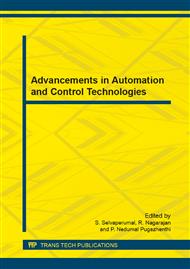[1]
Rodrıguez, J., Lai, J. -S., Peng, F.Z.: Multilevel inverters: a survey of topologies, controls, and applications, IEEE Trans. Ind. Electron., 2000, 49, (4), p.724–738.
DOI: 10.1109/tie.2002.801052
Google Scholar
[2]
Yuan, X., Barbi, I. Fundamentals of a new diode clamping multilevel inverter, IEEE Trans. Power Electron., 2000, 15, (4), p.711–718.
DOI: 10.1109/63.849041
Google Scholar
[3]
A. K. Sadigh, S. H. Hosseini, M. Sabahi, and G. B. Gharehpetian, Double flying capacitor multicell converter based on modified phase-shifted pulse width modulation, IEEE Trans. Power Electron., vol. 25, no. 6, p.1517–1526, Jun. (2010).
DOI: 10.1109/tpel.2009.2039147
Google Scholar
[4]
A. Nami, F. Zare, A. Ghosh, and F. Blaabjerg, A hybrid cascade converter topology with series-connected symmetrical and asymmetrical diode clamped H-bridge cells, IEEE Trans. Power Electron., vol. 26, no. 1, p.51–65, Jan. (2011).
DOI: 10.1109/tpel.2009.2031115
Google Scholar
[5]
Q. Song and W. Liu, Control of a cascade STATCOM with star configuration under unbalanced conditions, IEEE Trans. Power Electron., vol. 24, no. 1, p.45–58, Jan. (2009).
DOI: 10.1109/tpel.2008.2009172
Google Scholar
[6]
N. Flourentzou, V. G. Agelidis, and G. D. Demetriades, VSC-based HVDC power transmission systems: An overview, IEEE Trans. Power Electron., vol. 24, no. 3, p.592–602, Mar. (2009).
DOI: 10.1109/tpel.2008.2008441
Google Scholar
[7]
M. Hagiwara, K. Nishimura, and H. Akagi, A medium-voltage motor drive with a modular multilevel PWM inverter, IEEE Trans. Power Electron., vol. 25, no. 7, p.1786–1799, Jul. (2010).
DOI: 10.1109/tpel.2010.2042303
Google Scholar
[8]
N. Mohan, T. M. Undeland, andW. P. Robbins, Power Electronics: Converters, Applications, and Design, 2nd ed. New York: Wiley, (1995).
Google Scholar
[9]
P. N. Enjeti, P. D. Ziogas, and J. F. Lindsay, Programmed PWM techniques to eliminate harmonics: a critical evaluation, IEEE Trans. Ind. Applicat., vol. 26, p.302–316, Mar. /Apr. (1990).
DOI: 10.1109/28.54257
Google Scholar
[10]
H. S. Patel and R. G. Hoft, Generalized harmonic elimination and voltage control in thryristor inverters: part I—harmonic elimination, IEEE Trans. Ind. Applicat., vol. 9, p.310–317, May/June (1973).
DOI: 10.1109/tia.1973.349908
Google Scholar
[11]
Generalized harmonic elimination and voltage control in thryristor inverters: part II—voltage control technique, IEEE Trans. Ind. Applicat., vol. 10, p.666–673, Sept. /Oct. (1974).
DOI: 10.1109/tia.1974.349239
Google Scholar
[12]
J. Sun and I. Grotstollen, Pulsewidth modulation based on real-time solution of algebraic harmonic elimination equations, in Proc. 20th Int. Conf. Ind. Electron., Contr. Instrum. IECON, vol. 1, 1994, pp.
DOI: 10.1109/iecon.1994.397753
Google Scholar
[13]
John n. Chiasson, leon m. Tolbert, Keith j. Mckenzie, and zhong du, "A complete solution to the harmonic Elimination problem, IEEE trans. power electronics, vol. 19, no. 2, march (2004).
DOI: 10.1109/tpel.2003.823207
Google Scholar
[14]
David F. Gibson & Edward L. Mooney, Dual-Phase Simulation—A Mixed Time Frame Systems Analysis Tool, A I I E Transactions, Volume 9, Issue 4, 1977, pages 338-344.
DOI: 10.1080/05695557708975165
Google Scholar


